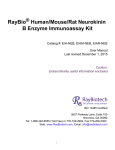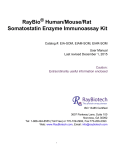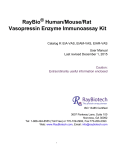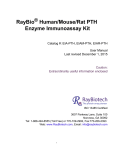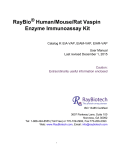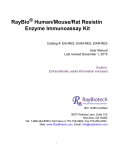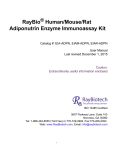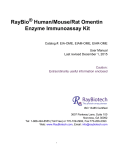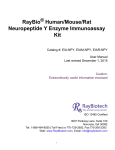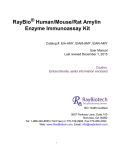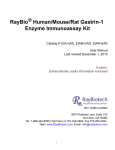Download Manual
Transcript
RayBio® Human/Mouse/Rat GIP Enzyme Immunoassay Kit Catalog #: EIA-GIP, EIAM-GIP, EIAR-GIP User Manual Last revised December 1, 2015 Caution: Extraordinarily useful information enclosed ISO 13485 Certified 3607 Parkway Lane, Suite 100 Norcross, GA 30092 Tel: 1-888-494-8555 (Toll Free) or 770-729-2992, Fax:770-206-2393 Web: www.RayBiotech.com, Email: [email protected] 1 Table of Contents Section Page # I. Introduction 3 II. General Description 4 III. How It Works 4 IV. Storage 5 V. Reagents 5 VI. Additional Materials Required 6 VII. Reagent Preparation A. Preparation of Plate and Anti-GIP Antibody B. Preparation of Biotinylated Peptide (Item F) C. Preparation of Standards D. Preparation of Positive Control E. Preparation of Samples F. Preparation of Wash Buffer and HRP-Strep 6 6 7 8 9 9 10 VIII. Assay Procedure 10 IX. Assay Procedure Summary 11 X. Calculation of Results A. Typical Data B. Sensitivity C. Detection Range D. Reproducibility E. Assay Diagram 12 12 12 12 12 13 XI. Specificity 14 XII. Select Publications 14 XIII. Troubleshooting Guide 15 Please read the entire manual carefully before starting your experiment 2 I. Introduction Gastric inhibitory polypeptide (GIP), also known as the glucose-dependent insulinotropic peptide belongs to the secretin family. GIP is derived from a 153amino acid proprotein and circulates as a biologically active 42-amino acid peptide. GIP is synthesized by K cells, which are found in the mucosa of the duodenum and the jejunum of the gastrointestinal tract as well as in beta-cells in the pancreas. GIP has been reported to play a role in neutralizing stomach acid to protect the small intestine from acid damage, reducing the rate at which food is transferred through the stomach, and inhibiting the GI motility and secretion of acid. Recently it has been believed that the function of GIP is to induce insulin secretion, which is primarily stimulated by hyperosmolarity of glucose in the duodenum. In addition, GIP has been reported to have significant effects on fatty acid metabolism through stimulation of lipoprotein lipase activity in adipocytes. GIP release has been demonstrated in the ruminant animal and may play a role in nutrient partitioning in milk production (lipid metabolism). GIP also has clinical applications. It has been reported that Type 2 diabetics are not responsive to GIP. Additionally, studies with knockout mice suggested that absence of GIP receptors correlates with resistance to obesity. 3 II. General Description The RayBio® GIP Enzyme Immunoassay (EIA) Kit is an in vitro quantitative assay for detecting GIP peptide based on the competitive enzyme immunoassay principle. In this assay, a biotinylated GIP peptide is spiked into the samples and standards. The samples and standards are then added to the plate, where the biotinylated GIP peptide competes with endogenous (unlabeled) GIP for binding to the anti-GIP antibody. After a wash step, any bound biotinylated GIP then interacts with horseradish peroxidase (HRP)-streptavidin, which catalyzes a color development reaction. The intensity of the colorimetric signal is directly proportional to the amount of captured biotinylated GIP peptide and inversely proportional to the amount of endogenous GIP in the standard or samples. A standard curve of known concentration of GIP peptide can be established and the concentration of GIP peptide in the samples can be calculated accordingly. III. How It Works 4 IV. Storage The entire kit may be stored at -20°C to -80°C for up to 6 months from the date of shipment. For extended storage, it is recommended to store at -80°C. Avoid repeated freeze-thaw cycles. For prepared reagent storage, see table below. V. Reagents Component Size / Description Storage / Stability After Preparation GIP Microplate (Item A) 96 wells (12 strips x 8 wells) coated with secondary antibody. 1 month at 4°C* Wash Buffer Concentrate (20X) (Item B) 25 ml of 20X concentrated solution. 1 month at 4°C Standard GIP Peptide (Item C) 2 vials of GIP Peptide. 1 vial is enough to run each standard in duplicate. The first standard: 2-3 days at 4°C Additional dilutions: Do not store Anti-GIP Polyclonal Antibody (Item N) 2 vials of anti-GIP. 1 month at 4°C Assay Diluent A (Item D) 30 ml, contains 0.09% sodium azide as preservative. Diluent for standards and serum or plasma. N/A Assay Diluent B (Item E) 15 ml of 5X concentrated buffer. Diluent for standards, cell culture media or other sample types, and HRP-Streptavidin. 1 month at 4°C Biotinylated GIP Peptide (Item F) 2 vials of Biotinylated GIP Peptide, 1 vial is enough to assay the whole plate. 2-3 days at 4°C HRP-Streptavidin Concentrate (Item G) 600 µl 400X concentrated HRP-conjugated streptavidin. Do not store and reuse Positive Control (Item M) 1 vial of Positive Control. 2-3 days at 4°C TMB One-Step Substrate Reagent (Item H) 12 ml of 3,3,5,5'-tetramethylbenzidine (TMB) in buffer solution. N/A Stop Solution (Item I) 8 ml of 0.2 M sulfuric acid. N/A *Return unused wells to the pouch containing desiccant pack, reseal along entire edge. 5 VI. Additional Materials Required 1. 2. 3. 4. 5. 6. 7. 8. 9. 10. 11. Microplate reader capable of measuring absorbance at 450 nm Precision pipettes to deliver 2 µl to 1 ml volumes Adjustable 1-25 ml pipettes for reagent preparation 100 ml and 1 liter graduated cylinders Absorbent paper Distilled or deionized water SigmaPlot software (or other software which can perform four-parameter logistic regression models) Tubes to prepare standard or sample dilutions Orbital shaker Aluminum foil Plastic wrap VII. Reagent Preparation Keep kit reagents on ice during reagent preparation steps. Note: Assay Diluent A should be used for dilution of samples, Item F and Item C when testing plasma or serum samples. 1X Assay Diluent B should be used for dilution of samples, Item F and Item C when testing cell culture media or other sample types. A. Preparation of Plate and Anti-GIP Antibody 1. Equilibrate plate to room temperature before opening the sealed pouch. 2. Label removable 8-well strips as appropriate for your experiment. 3. 5X Assay Diluent B (Item E) should be diluted 5-fold with deionized or distilled water. 4. Briefly centrifuge the anti-GIP antibody vial (Item N) Then add 50 µl of 1X Assay Diluent B to the vial to prepare the antibody concentrate. Pipette up and down to mix gently. 5. The antibody concentrate should then be diluted 100-fold with 1X Assay Diluent B. This is your anti-GIP antibody working solution, which will be used in step 2 of Assay Procedure (Section VIII). 6 Note: The following steps may be done during the antibody incubation procedure (step 2 of Assay Procedure) B. Preparation of Biotinylated GIP (Item F) 5. Briefly centrifuge the vial of Biotinylated GIP (Item F) before use. 6. See the image below for proper preparation of Item F. Transfer the entire contents of the Item F vial into a tube containing 10 ml of the appropriate Assay Diluent. This is your Working Stock of Item F. Pipette up and down to mix gently. The final concentration of biotinylated GIP will be 20 pg/ml. a. Second Dilution of Item F for Standards: Add 2 ml of Working Stock Item F to 2 ml of the appropriate Assay Diluent. The final concentration of biotinylated GIP will be 10 pg/ml. b. Second Dilution of Item F for Positive Control: Add 100 µl of Working Stock Item F to 100 µl of the prepared Positive Control (Item M). (See section D for Positive Control preparation) The final concentration of biotinylated GIP will be 10 pg/ml. c. Second Dilution of Item F for samples: Add 125 µl of Working Stock Item F to 125 µl of prepared sample (see section E for sample preparation). This is a 2-fold dilution of your sample. The final concentration of biotinylated GIP will be 10 pg/ml. 7 C. Preparation of Standards 7. Label 6 microtubes with the following concentrations: 1000 pg/ml, 100 pg/ml, 10 pg/ml, 1 pg/ml, 0.1 pg/ml and 0 pg/ml. Pipette 450 µl of biotinylated GIP Item F working solution (prepapred in step 6a) into each tube, except the 1,000 pg/ml (leave this one empty). It is very important to make sure the concentration of biotinylated GIP is 10 pg/ml in all standards. 8. Briefly centrifuge the vial of GIP Standard (Item C). Pipette 8 µl of Item C and 792 µl of 10 pg/ml biotinylated GIP working solution (prepared in step 6a) into the tube labeled 1000 pg/ml. Mix thoroughly. This solution serves as the first standard (1000 pg/ml GIP standard, 10 pg/ml biotinylated GIP). 9. To make the 100 pg/ml standard, pipette 50 µl of the 1000 pg/ml GIP standard into the tube labeled 100 pg/ml. Mix thoroughly. 10. Repeat this step with each successive concentration, preparing a dilution series as shown in the illustration below. Each time, use 450 µl of biotinylated GIP and 50 µl of the prior concentration until the 0.1 pg/ml is reached. Mix each tube thoroughly before the next transfer. 8 D. Positive Control Preparation 11. Briefly centrifuge the Positive Control vial (Item M). 12. Refer to step 6b. This is a 2-fold dilution of the Positive Control. The final concentration of biotinylated GIP should still be 10 pg/ml. The Positive Control is a cell culture media sample that serves as a system control to verify that the kit components are working. The resulting OD will not be used in any calculations; if no positive competition is observed please contact RayBiotech Technical Support. The Positive Control may be diluted further if desired, but be sure the final concentration of biotinylated GIP is 10 pg/ml. E. Sample Preparation 13. If you wish to perform a 2-fold dilution of your sample, proceed to step 6c. If you wish to perform a higher dilution of your sample, dilute your sample with the appropriate Assay Diluent before performing step 6c. EXAMPLE (to make a 4-fold dilution of sample): a. Dilute sample 2-fold (62.5 µl of sample + 62.5 µl of the appropriate Assay Diluent.). b. Perform step 6c (125 µl of working solution Item F + 125 µl of sample prepared above). The total volume is 250 µl, enough for duplicate wells on the microplate. It is very important to make sure the final concentration of the biotinylated GIP is 10 pg/ml. Note: Optimal sample dilution factors should be determined empirically, however you may reference below for recommended dilution factors for serum: Human=2X Mouse=2X Rat=2X. If you have any questions regarding the recommendended dilutions you may contact technical support at 888-494-8555 or [email protected]. 9 F. Preparation of Wash Buffer and HRP 14. If Item B (20X Wash Concentrate) contains visible crystals, warm to room temperature and mix gently until dissolved. 15. Dilute 20 ml of Wash Buffer Concentrate into deionized or distilled water to yield 400 ml of 1X Wash Buffer. 16. Briefly centrifuge the HRP-Streptavidin vial (Item G) before use. 17. Dilute the HRP-Streptavidin concentrate 400-fold with 1X Assay Diluent B. Note: do not use Assay Diluent A for HRP-Streptavidin preparation in step 17 VIII. Assay Procedure 1. Keep kit reagents on ice during reagent preparation steps. It is recommended that all standards and samples be run at least in duplicate. 2. Add 100 µl of Anti-GIP Antibody (Item N) (See Reagent Preparation step 3) to each well. Incubate for 1.5 hours at room temperature with gentle shaking (1-2 cycle/sec). You may also incubate overnight at 4ºC. 3. Discard the solution and wash wells 4 times with 1X Wash Solution Buffer (200300 µl each). Washing may be done with a multichannel pipette or an automated plate washer. Complete removal of liquid at each step is essential to good assay performance. After the last wash, remove any remaining Wash Buffer by aspirating or decanting. Invert the plate and blot it against clean paper towels. 4. Add 100 µl of each standard (see Reagent Preparation Section C), Positive Control (see Reagent Preparation Section D) and sample (see Reagent Preparation Section E) in appropriate wells. Be sure to include a blank well (Assay Diluent only). Cover wells and incubate for 2.5 hours at room temperature with gentle shaking (1-2 cycles/sec) overnight or at 4ºC. 5. Discard the solution and wash 4 times as directed in Step 3. 6. Add 100 µl of prepared HRP-Streptavidin solution (see Reagent Preparation step 7) to each well. Incubate for 45 minutes at room temperature with gentle 10 shaking. It is recommended that incubation time should not be shorter or longer than 45 minutes. 7. Discard the solution and wash 4 times as directed in Step 3. 8. Add 100 µl of TMB One-Step Substrate Reagent (Item H) to each well. Incubate for 30 minutes at room temperature in the dark with gentle shaking (1-2 cycles/sec). 9. Add 50 µl of Stop Solution (Item I) to each well. Read at 450 nm immediately. IX. Assay Procedure Summary 1. Prepare all reagents, samples and standards as instructed. 2. Add 100 µl anti-GIP to each well. Incubate 1.5 hours at room temperature or overnight at 4ºC. 3. Add 100 µl standard or sample to each well. Incubate 2.5 hours at room temperature or overnight at 4ºC. 4. Add 100 µl prepared Streptavidin solution. Incubate 45 minutes at room temperature. 5. Add 100 µl TMB One-Step Substrate Reagent to each well. Incubate 30 minutes at room temperature. 6. Add 50 µl Stop Solution to each well. Read at 450 nm immediately. 11 X. Calculation of Results Calculate the mean absorbance for each set of duplicate stands, controls, and samples and subtract the blank optical density. Plot the standard curve using SigmaPlot software (or other software which can perform four-parameter logistic regression models), with standard concentration on the x-axis and percentage of absorbance (see calculation below) on the y-axis. Draw the best-fit curve through the standard points. Percentage absorbance = (B-blank OD)/B 0-blank OD) where B = OD of sample or standard and B0 = OD of zero standard (total binding) A. Typical Data These standard curves are for demonstration only. A standard curve must be run with each assay. B. Sensitivity The minimum detectable concentrations of GIP is 1.25 pg/ml. C. Detection Range 0.1-1,000 pg/ml D. Reproducibility Intra-Assay: CV<10% Inter-Assay: CV<15% 12 E. Assay Diagram Recommended Plate Layout: Key: Blank = Buffer Only Total Binding = Biotin-GIP only Standard 1 = 1000 pg/ml Standard 2 = 100 pg/ml Standard 3 = 10 pg/ml Standard 4 = 1 pg/ml Standard 5 = 0.1 pg/ml Pos Control = Biotin with Item M 13 XI. Specificity Cross Reactivity: This EIA kit shows no cross-reactivity with any of the cytokines tested: Ghrelin, Nesfatin, Angiotensin II, NPY and APC. XIV. Select EIA Publications 1. Plum L, Lin HV, Dutia R, Tanaka J, Aizawa KS, et al. The Obesity Susceptibility Gene Carboxypeptidase E Links FoxO1 Signaling in Hypothalamic Proopiomelanocortin Neurons with Regulation of Food Intake. Nature Med. 2009;15(10):1195-1201. (Ghrelin EIA, EIA-GHR-1) 2. Hug C, Lodish HF. Visfatin: a new adipokine. Science. 2005; 307(5708):366-7. 3. Kim MK. Crystal structure of visfatin/pre-B cell colony-enhancing factor 1/nicotinamide phosphoribosyltransferase, free and in complex with the anticancer agent FK-866. J Mol Biol. 2006; 362(1):66-77. 4. Revollo, J.R., et al. The NAD biosynthesis pathway mediated by nicotinamide phosphoribosyltransferase regulates Sir2 activity in mammalian cells. J. Biol. Chem. 2004; 279: 50754-50763. 5. Oh-I S, Shimizu H, Satoh T, et al. Identification of nesfatin-1 as a satiety molecule in the hypothalamus. Nature 2006; 443 (7112): 709-12. 6. Zhang J, Ren P, Avsian-Kretchmer O, Luo C, Rauch R, Klein C, Hsueh A. Obestatin, a peptide encoded by the ghrelin gene, opposes ghrelin's effects on food intake. Science 2005; 310 (5750): 996-9. 7. Cummings D, Weigle D, Frayo R, Breen P, Ma M, Dellinger E, Purnell J. Plasma ghrelin levels after diet-induced weight loss or gastric bypass surgery. N Engl J Med 2002; 346 (21): 1623-30. 8. Tschop M, Smiley DL, Heiman ML. Ghrelin induces adiposity in rodents. Nature 2002; 407 (6806): 908-913.9. Kojima M, Hosoda H, Date Y, Nakazato M, Matsuo H, Kangawa K. Ghrelin is a growth-hormone-releasing acylated peptide from stomach. Nature 1999; 402 (6762): 656-60. 14 XIII. Troubleshooting Guide Problem Cause Solution Inaccurate pipetting Improper standard dilution Check pipettes Briefly centrifuge Item C and dissolve the powder thoroughly by gently mixing Low signal Improper preparation of standard and/or biotinylated antibody Too brief incubation times Inadequate reagent volumes or improper dilution Briefly spin down vials before opening. Dissolve the powder thoroughly. Ensure sufficient incubation time; assay procedure step 2 may be done overnight Check pipettes and ensure correct preparation Large CV Inaccurate pipetting Air bubbles in wells Check pipettes Remove bubbles in wells High background Plate is insufficiently washed Contaminated wash buffer Review the manual for proper wash. If using a plate washer, ensure that all ports are unobstructed. Make fresh wash buffer Improper storage of the ELISA kit Stop solution Follow storage recomendations in sections IV and V. Keep substrate solution protected from light. Add stop solution to each well before reading plate Poor standard curve Low sensitivity 15 RayBio® ELISA Kits Over 2,000 ELISA kits available, visit www.RayBiotech.com/ELISA-Kits.html for details. This product is for research use only. ©2015 RayBiotech, Inc 16
















